
|
| |
| Belmont,
the first station on the branch, is sited one and a
quarter miles down the line from the junction at Sutton.
The area consisted of less than a dozen scattered
agricultural labourer's cottages before the South
Metropolitan District School was constructed between 1852
and 1855. It served to accommodate children from
impoverished south London families and was heavily
extended shortly after the opening of the railway line.
The presence of a railway station also triggered housing
developments, and in the 1880s the first shops were
opened - not surprisingly in Station Road. A post office
was opened in 1890, by which time the number of
inhabitants at Belmont had more than doubled in ten years
to a total of 450 - not a very large number by any
standards, but that same year a staggering 1,800 children
were recorded to be in attendance at the Met District
School (Kirby, 1983). |
| |
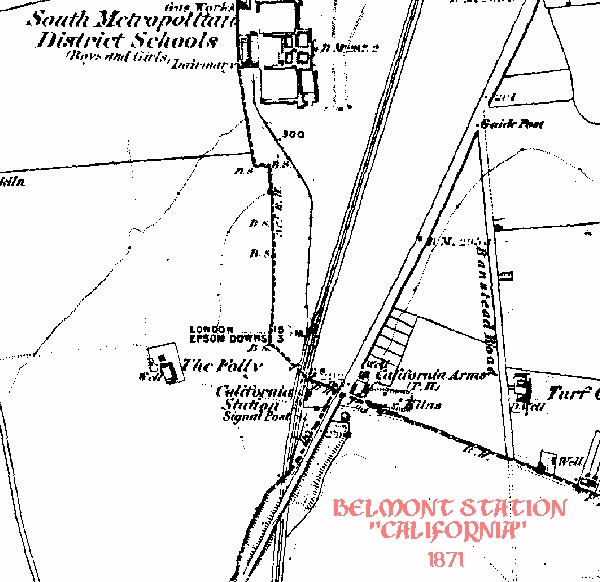
|
|
The
school was closed as a consequence of the 1902
Education Act, and Belmont remained a very rural
place right up until the 1930s, with the village
growing around the railway station.
The station has quite a chequered
history in respect to its name, having started
out in life as "California". The
LB&SCR chose this name with reference to the
"California Arms" pub which existed
there since 1861 and which can be seen on the
1871 survey map.
There are many stories relating
how traffic destined for this station would quite
often end up in the United States as officially
there was no such place in Britain. Legend
therefore has it that the stationmaster, faced
with massive losses of consignments, suggested
the renaming of the station (Kirby, 1983), and
the station's name was changed to Belmont in
1875.
The "California Arms"
however remained in place until destroyed by a
direct German bomb hit in April 1941; rebuilt in
the 1950s, it too was eventually renamed
"The Belmont" in the 1980s.
The 1871 survey map also
shows the private siding for the South
Metropolitan Districts School, which was put out
of use and lifted around 1889. The land in the
vicinity at this time was still devoid of any
housing.
|
|
| |
| As traffic
flows came, changed, and went, all three stations on the
branch saw considerable changes in their track layouts
over time. Plans from 1865 indicate that both Belmont
(still California at the time) and Banstead had goods
yards, although mysteriously goods trains didn't appear
in the working timetables until 1872 (Kirby, 1983). The
trackplan below indicates the single track (black) that
has served the station since October 1982, along with
track that existed around 1920 but has been lifted over
time (blue); Belmont goods yard closed in 1969. |
| |
 |
| |
| But things
are changing again. In January 2023 Sutton Council was
able to announce that it had secured a £14.1 million
cash injection from the government’s Levelling Up
Fund in order to double the number of trains running to
Belmont and thus improve public transport access to the
London Cancer Hub being developed in Belmont, poised to
create 13,000 jobs (Sutton.gov.uk, 2023). The
proposal is to have "a siding turnback south of
Belmont Station", which essentially means that the
original double track from Sutton to Belmont will be
reinstated. As the old track bed is still entirely within
the existing railway boundary, no purchase of land is
needed. The plan is to have the double track extension in
operation by 2026. |
| |
| The
original station building of 1865 was severly damaged in
1940 by enemy action with "one side of Belmont
station destroyed" (Robinson, 2005) and then
completely destroyed in a bombing on 15 April 1941,
killing 10 people and injuring many more (Edwards, 1959).
There was nothing left to be rebuilt, and the
station building was replaced with a prefabricated wooden
ticket office. |
| |
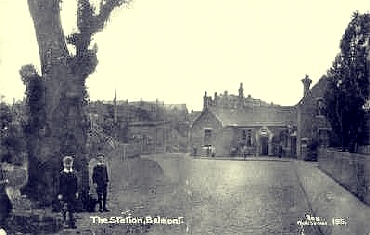
Belmont station
building, and looking towards Sutton (c.1920)
|
|
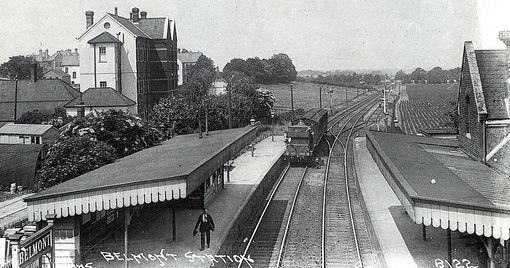
|
|
| |
In time this was
followed by a concrete CLASP (Consortium
of Local Authorities Special Programme) shelter as part of a scheme developed in
the 1950s by English local authorities to designe and
assemble prefabricated buildings for use in the public
sector. Belmont's concrete shelter
became a fairly dismal affair over the years, and was
finally removed by South Central as part of their station
"upgrading programme" in 2004. The wording was
slightly paradoxical in this case, as the upgrade
resulted in the facilities being reduced to a simple
shelterless platform. A proper refurbishment of the
station concourse was then undertaken by Southern in
2005, adding a modern shelter, passenger information
points, and a ticket vending machine.
|
| |
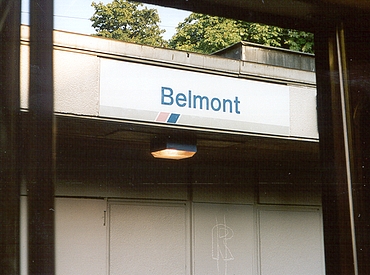
Station name sign on the concrete shelter
building in 2000
|
|
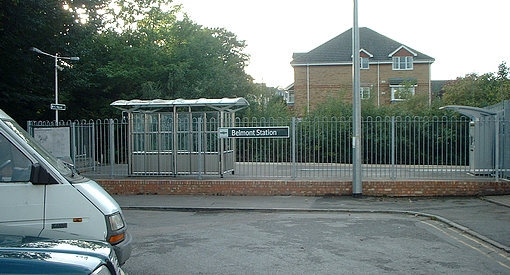
The station
forecourt in 2005, after station refurbishment by
Southern
|
|
| |
| The area
has seen many changes as the open spaces which existed
during the first fifty years of the railway line's
existence gradually disappeared, as the comparison of
historic and contemporary views of the station area
illustrates. |
| |
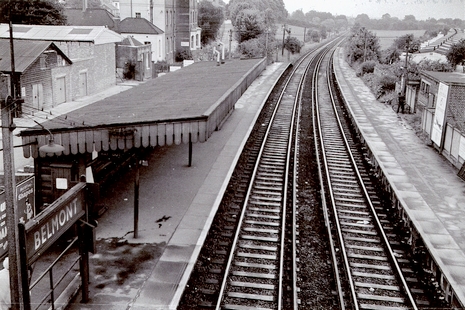 |
|
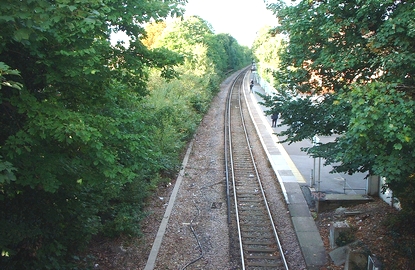
The view towards Sutton in 1961 (left, Ben
Brooksbank photograph, creative commons) and in
2005 (above)
|
|
| |
| Between 1961 and 2005,
the scene has changed almost beyond recognition as the
down line track and platform serve as the only points of
reference left when comparing the two views, whereas the
abundance of trees hides the fact that there are actually
rows of houses to the left of the railway line. The view
looking towards Banstead (below) has changed in a
similarly dramatic way over time. The view from Station
Road Bridge in an early 1920s postcard (with Belmont
Signal Box) is hardly recognizable in September 2005.
|
| |
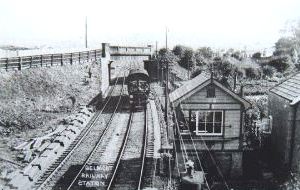
Brighton
Road Bridge in the background is the one common
landmark - other than the now single track - that
remains and serves as a point of orientation.
|
|
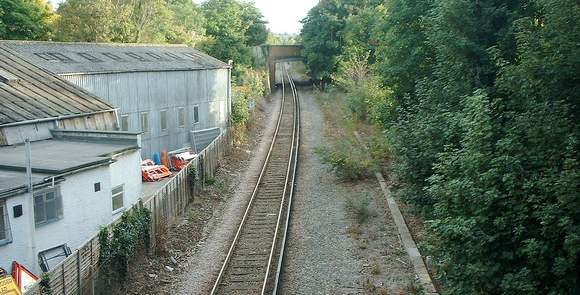
|
|
| |
| Station
Road Bridge, situated just a few yards away from the
Banstead end of the platform, has served as vintage
viewpoint for photographers of Belmont station for
decades. All the above views - historic and contemporary
- were taken looking down from this structure. |
| |
| The
reduction of the branch to single track on 3rd October
1982 made both the original up platform and the
footbridge (needed to get there from the main station
area) redundant. As with Banstead station, the abandoned
platform site quickly became overgrown, but remnants
could still be seen thrirty years later. Also still in place and visible (in
the left hand foreground of the picture on the right) are
the concrete foundations of the footbridge. No doubt
these scenes will, once more, change significantly once
the line is double-tracked again to this point. |
| |
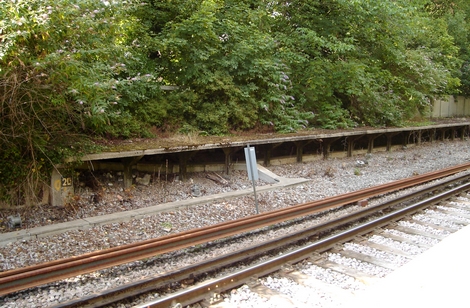
10 August 2006
|
|
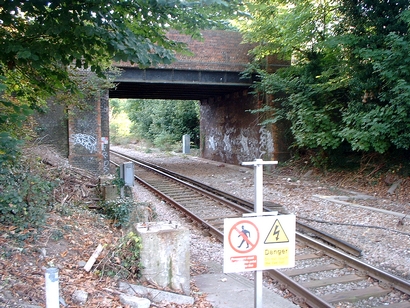
27 September 2005
|
|
| |
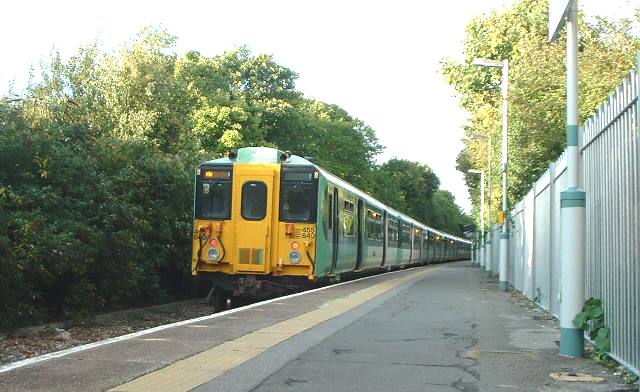
Refurbished Cl 455
840 leaves Belmont with a London Victoria service on 27
September 2005 (at which point in time the platform had
received new fencing)
|
| |
|
